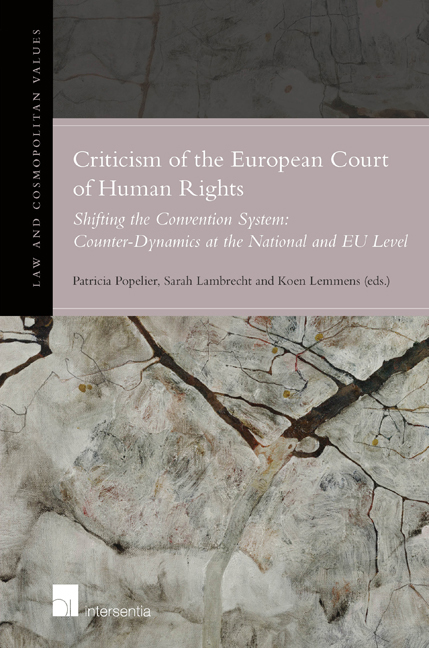 Criticism of the European Court of Human Rights
Criticism of the European Court of Human Rights Book contents
- Frontmatter
- Contents
- List of Abbreviations
- PART I INTRODUCTORY
- Chapter 1 Introduction: Purpose and Structure, Categorisation of States and Hypotheses
- Chapter 2 Criticising the European Court of Human Rights or Misunderstanding the Dynamics of Human Rights Protection?
- Chapter 3 European Union: The EU's Attitude to the ECHR
- PART II SPARSE CRITICISM
- PART III MODERATE CRITICISM
- PART IV STRONG CRITICISM
- PART V HOSTILE CRITICISM
- PART VI SYNTHESIS
- APPENDIX
Chapter 1 - Introduction: Purpose and Structure, Categorisation of States and Hypotheses
from PART I - INTRODUCTORY
Published online by Cambridge University Press: 13 December 2017
- Frontmatter
- Contents
- List of Abbreviations
- PART I INTRODUCTORY
- Chapter 1 Introduction: Purpose and Structure, Categorisation of States and Hypotheses
- Chapter 2 Criticising the European Court of Human Rights or Misunderstanding the Dynamics of Human Rights Protection?
- Chapter 3 European Union: The EU's Attitude to the ECHR
- PART II SPARSE CRITICISM
- PART III MODERATE CRITICISM
- PART IV STRONG CRITICISM
- PART V HOSTILE CRITICISM
- PART VI SYNTHESIS
- APPENDIX
Summary
PURPOSE OF THE EDITED VOLUME
For some time now, the European Court of Human Rights is under substantial pressure. From a case overload crisis it stumbled into a legitimacy crisis with regard to certain countries. The most severe criticism has been voiced in the UK, where ‘charges against the Court … over the past two years have been unprecedented’. Also voices outside the UK, however, have subscribed to these views. This should be taken seriously, since scholars warn that institutions with eroding legitimacy risk demise or reform. This is exactly what the Strasbourg Court was facing within the reform talks leading up to the Brighton Conference under the UK Chairmanship of the Committee of Ministers of the Council of Europe. Ultimately, however, the Brighton Declaration advanced for the most part a technical reform. It is therefore unlikely that the Brighton Declaration and the ensuing Protocol No 15 will be able to tone down opponents of an activist European Court. The Court will thus very carefully need to maintain the difficult balance between human rights protection and respect for national sovereignty.
The goal of this volume is to explore how widespread this critical attitude of the European Court of Human Rights really is. Secondly, the volume assesses to what extent such criticism is being translated in strategies at the political level or at the judicial level and brings about concrete changes in the dynamics between national and European fundamental rights protection. These questions have so far remained largely unexplored, especially cross-nationally. Therefore, the focus is not solely put on countries that are known to have highly critical voices and that, particularly in the case of the UK, have been heavily documented. Rather, we aim to evaluate whether a change in dynamics is a pan-European reality or merely limited to a few countries.
For this reason, our coverage is wide, compromising fifteen Contracting Parties and the EU, as a future Contracting Party. Every in-depth report is based on the same structured questionnaire, which can be found in the annex. The authors also followed the same chapter template which coincides with the questionnaire, as to encourage easy comparison for the reader.
- Type
- Chapter
- Information
- Criticism of the European Court of Human RightsShifting the Convention System: Counter-dynamics at the National and EU Level, pp. 3 - 22Publisher: IntersentiaPrint publication year: 2016
- 1
- Cited by
